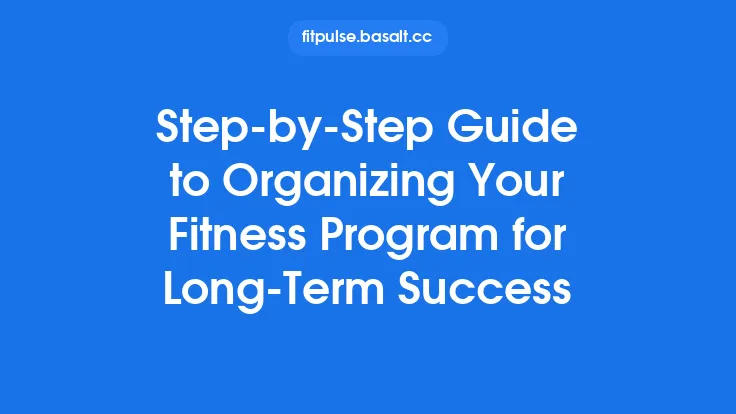Integrating fitness into daily life is less about carving out isolated workout windows and more about weaving movement, recovery, and mindset into the fabric of everyday existence. When exercise becomes a natural extension of who you are and how you live, it transcends the realm of a scheduled task and transforms into a sustainable lifestyle pillar. This shift from “doing” to “being” creates the foundation for long‑term success, allowing you to maintain progress even as life’s circumstances evolve.
Understanding the Foundations of Lifestyle Integration
A truly integrated fitness routine rests on three interdependent pillars: behavioral alignment, physiological adaptability, and environmental support.
- Behavioral Alignment – Your daily actions must reflect a coherent set of values and priorities. When the desire to stay active aligns with personal goals—whether it’s being present for family, excelling at work, or preserving health in later years—the effort feels purposeful rather than burdensome.
- Physiological Adaptability – The body thrives on progressive, varied stimuli. By employing principles such as progressive overload, periodization, and functional movement, you ensure that the physiological stress placed on muscles, joints, and the cardiovascular system is appropriate for long‑term development without causing chronic fatigue or injury.
- Environmental Support – The spaces you inhabit can either invite movement or reinforce sedentary habits. Simple modifications—like placing a kettlebell near the kitchen counter or arranging a standing desk—create visual cues that prompt activity without requiring deliberate planning each day.
When these pillars are deliberately cultivated, fitness becomes an automatic, low‑friction component of daily life.
The Psychology of Habit Formation
Habits are the brain’s efficient way of conserving energy. The classic habit loop—cue → routine → reward—offers a roadmap for embedding exercise into everyday patterns.
- Cue: Identify an existing, reliable trigger in your routine. It could be the moment you finish brushing your teeth, the sound of the kettle boiling, or the arrival of a specific podcast episode.
- Routine: Pair the cue with a brief, repeatable movement sequence. This might be a set of bodyweight squats, a 5‑minute mobility flow, or a quick stair climb. The key is consistency; the routine should be simple enough to perform automatically.
- Reward: Reinforce the behavior with an immediate, satisfying payoff. This could be the sense of accomplishment after completing the movement, a brief stretch that feels good, or a mental note of “I’m taking care of myself.” Over time, the brain begins to anticipate the reward, strengthening the habit loop.
Research shows that habit formation typically requires 21–66 days of consistent repetition, depending on complexity and individual differences. Patience and persistence are essential; early lapses are normal and should be viewed as data points for refinement rather than failures.
Designing an Environment that Encourages Movement
Your surroundings can dramatically influence the ease with which you adopt active habits. Consider the following strategies to make movement the path of least resistance:
- Visibility: Store equipment where you can see it. A yoga mat rolled out in the living room or a jump rope hanging on a hook near the front door serves as a constant reminder.
- Accessibility: Keep frequently used items within arm’s reach. If you enjoy short bouts of cardio, place a compact step platform near the TV so you can step while watching a show.
- Zoning: Create dedicated “movement zones” in each room. For example, a corner of the bedroom could host a balance board, while the kitchen counter could hold a set of resistance bands for quick strength circuits while cooking.
- Lighting and Ambiance: Bright, natural light can boost energy levels and motivation. If possible, position your activity space near a window or use full‑spectrum lighting to simulate daylight.
These environmental tweaks reduce the mental friction associated with initiating movement, allowing the habit loop to operate more fluidly.
Building a Fitness Identity for Longevity
Identity‑based habits are among the most resilient. When you start to see yourself as “someone who moves,” the behavior aligns with self‑perception, making it less likely to be abandoned during stressful periods.
- Self‑Labeling: Begin by adopting a simple label—“I’m an active person.” Write it down and revisit it regularly.
- Narrative Reinforcement: Reflect on moments when movement contributed positively to your day—whether it improved mood, sharpened focus, or enhanced sleep. Incorporate these stories into your personal narrative.
- Public Commitment: Sharing your identity with friends, family, or a community group adds a layer of accountability. The social expectation reinforces the internal label.
Over time, this identity becomes a self‑fulfilling prophecy, guiding choices that support an active lifestyle even when external circumstances shift.
Strategic Progression: Periodization and Adaptive Overload
Long‑term success hinges on systematic progression that respects the body’s capacity to adapt. Two cornerstone concepts are periodization and adaptive overload.
- Adaptive Overload – To stimulate growth, the training stimulus must gradually increase. This can be achieved by manipulating variables such as load (weight), volume (sets × reps), intensity (percentage of maximal effort), or complexity (adding new movement patterns). The principle is simple: if the stimulus remains static, adaptation plateaus.
- Periodization – Rather than applying a constant overload, periodization cycles training stress to optimize performance and recovery. A classic model includes:
- Macrocycle (12–24 months): The overarching plan aligned with long‑term goals (e.g., improving overall health, maintaining functional strength).
- Mesocycle (4–12 weeks): Focused phases such as “strength building,” “mobility emphasis,” or “endurance consolidation.”
- Microcycle (1 week): The weekly arrangement of specific sessions, allowing for progressive variation while maintaining balance.
By rotating emphasis, you prevent overuse injuries, sustain motivation through variety, and ensure that each physiological system receives adequate stimulus and recovery.
Practical tip: Even without a formal calendar, you can adopt a “wave” approach—spend three weeks gradually increasing load, followed by a lighter “deload” week where volume is reduced. This rhythm can be intuitively aligned with natural energy cycles (e.g., higher intensity during periods of low stress, lighter work when life demands more mental bandwidth).
Synergizing Nutrition, Recovery, and Training
Fitness does not exist in isolation; it is intimately linked to nutrition, sleep, and stress management.
- Nutrient Timing: While precise timing is less critical for most recreational athletes, aligning protein intake with post‑activity windows (within 2 hours) supports muscle repair. Consistent daily protein distribution (e.g., 20–30 g per meal) is more impactful than occasional “pre‑workout” meals.
- Hydration: Even mild dehydration can impair strength, endurance, and cognitive function. Aim for a baseline of 2–3 L of water daily, adjusting for climate, activity level, and individual sweat rates.
- Sleep Hygiene: Quality sleep (7–9 hours) is the primary recovery modality. Prioritize a dark, cool sleeping environment, limit screen exposure before bed, and maintain a consistent sleep‑wake schedule.
- Active Recovery: Low‑intensity activities—such as gentle yoga, walking, or light cycling—enhance circulation and facilitate metabolic waste removal without adding significant stress.
When these pillars are aligned, the body becomes more resilient, allowing you to sustain higher training loads over the long term.
Leveraging Social and Community Support
Human beings are inherently social; leveraging this trait can amplify adherence.
- Shared Activities: Engage in group hikes, family bike rides, or community sports leagues. The social element transforms exercise into a relational experience rather than a solitary chore.
- Peer Modeling: Surround yourself with individuals who embody the active lifestyle you aspire to. Observational learning reinforces norms and provides informal mentorship.
- Accountability Partnerships: Pair with a friend who shares similar goals. Regular check‑ins—whether a quick coffee chat or a brief walk together—create mutual responsibility.
These connections embed fitness within a broader social context, making it more enjoyable and less likely to be abandoned during challenging periods.
Monitoring Progress Without Overreliance on Technology
While digital tools can be helpful, long‑term integration thrives on internal awareness and simple, low‑tech tracking methods.
- Training Logbook: A paper notebook where you record key variables (exercise, sets, reps, perceived effort) fosters mindfulness. Reviewing entries weekly highlights trends and informs adjustments.
- Body Awareness Checks: Periodically assess how you feel during daily tasks—climbing stairs, lifting groceries, playing with children. Improvements in ease and reduced fatigue are tangible markers of progress.
- Performance Benchmarks: Set functional benchmarks (e.g., completing a 10‑minute bodyweight circuit, achieving a specific squat depth) and reassess quarterly. These concrete goals provide motivation without the need for complex metrics.
By focusing on qualitative feedback and simple quantitative records, you maintain a clear picture of advancement while avoiding the distraction of constant data streams.
Adapting to Life’s Natural Rhythms
Life is dynamic; the ability to fluidly adjust your fitness approach is essential for longevity.
- Seasonal Shifts: Embrace outdoor activities in warmer months (running, swimming) and indoor modalities during colder periods (strength circuits, yoga). This natural variation prevents monotony and aligns with environmental conditions.
- Life‑Stage Considerations: As responsibilities evolve—parenthood, career changes, aging—re‑evaluate priorities and modify movement choices accordingly. For instance, a focus on joint health and mobility may become more prominent in later decades.
- Energy Flow: Listen to your body’s daily energy patterns. On days when you feel naturally vigorous, opt for higher‑intensity sessions; on lower‑energy days, prioritize mobility, stretching, or restorative practices.
Adapting rather than rigidly adhering to a fixed plan ensures that fitness remains a supportive element rather than a source of stress.
Sustaining Integration for Long‑Term Success
The ultimate goal is to make movement an inseparable thread woven through every facet of daily life. By aligning behavior with personal values, constructing supportive environments, cultivating an active identity, and employing systematic progression, you create a resilient framework that endures beyond fleeting motivation spikes.
Remember that integration is a process, not a one‑time event. Regularly revisit each pillar, celebrate incremental gains, and remain open to refinement. When fitness becomes a natural expression of who you are and how you live, long‑term success follows organically.





